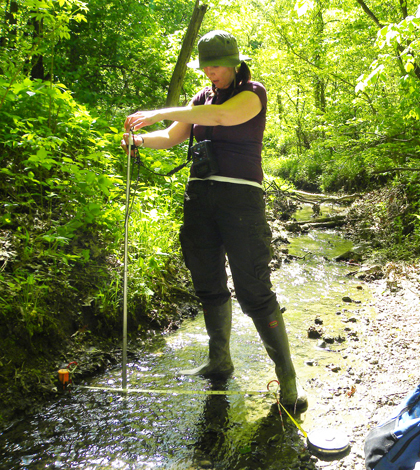Not all stream-side forests are up to task of nutrient filtering

Michaeleen Gerken Golay measures stream flow in a forested headwater stream
Preserving stream-side forests is a popular conservation strategy for preventing nutrients from urban and agricultural runoff from degrading water quality. But a recently published study shows not all forests are equally up for the task.
Forests alongside streams can sponge up the extra nutrients generated by agriculture and urban development. But those land uses can also change the plant community that populates the forest floor, degrading its ability to perform ecosystem services like nutrient filtering.
“We’re looking at systems that have changed over the course of our interacting with them. So we can’t expect that they’re going to work the same way they did before we came along,” said Michaeleen Gerken Golay, lead author of the study and an assistant professor of biology at Silver Lake College in Mantiwoc, Wis.
Gerken Golay, along with collaborators from Jan Thompson’s lab at Iowa State University, investigated the nutrient content of both the water in forested streams and the plants in the surrounding understory. The researchers also characterized which species made up the plant community on the forest floor.
The land use around each study forest and stream was classified as either urban, agricultural (grazed by livestock) or preserved. The researchers found that the forests, despite supporting hardwood tree canopies that appeared similar in aerial photographs, differed significantly among the three land uses in their understory and ability to take up nutrients.
“From above, they all looked like they should be behaving similarly,” Gerken Golay said. “But when we got down in there we could see that the vegetation on the forest floor was very different.”

Gerken Golay and field assistant (Rob Manatt) survey herbaceous vegetation in an urban forest (Credit: Zak Keninger)
The preserved forests harbored abundant native species, while the grazed and urban forests had sparser growth and more invasive species. Analysis of the nutrient content of plants at each site showed that the preserved forests’ natives retained more nitrogen than the invasive in the grazed and urban sites.
That’s a result of the structure of forest specialist species, Gerken Golay said.
“They have a lot more underground biomass, and that’s where they store the nutrients,” she said. “The weedy and invasive species just don’t have as much perennial biomass to store nutrients.”
The differences in understory plant biomass among the forests appeared to influence nitrogen loads in the streams flowing through them. Nitrogen loads in streams of urban forests were higher than those in streams of preserved forests.

Debris and invasive plants near an urban forested stream (Credit: Zak Keninger)
That’s presumably the result of the plants taking up and storing nutrients before they can leak into the stream, though that’s a difficult relationship to statistically nail down, Gerken Golay said.
“That is hard to pinpoint because anybody who’s studied nature can tell you there’s a lot going on,” she said. “To try to narrow it down to just a couple factors is going to be a headache.”
The results of the study, published in the Journal of Soil and Water Conservation, suggest that preserving forests around streams in urban and agricultural watersheds isn’t the last step in mitigating nutrient pollution. Land managers should also consider promoting native plant communities within riparian forests to bolster the ecosystem services.
“We can’t just expect that they’re all doing the same amount of work because they are a forest,” she said. “What we can do is restoration. If we know these plants can play a big role in keeping the nutrients out of the water, we can restore more plants to those forest understories.”
Top image: Michaeleen Gerken Golay measures stream flow in a forested headwater stream (Credit: Zak Keninger)




0 comments